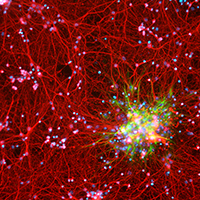Quantitative, structural and molecular changes in neuroglia of aging mammals: A review

Accepted: 27 May 2021
HTML: 11
All claims expressed in this article are solely those of the authors and do not necessarily represent those of their affiliated organizations, or those of the publisher, the editors and the reviewers. Any product that may be evaluated in this article or claim that may be made by its manufacturer is not guaranteed or endorsed by the publisher.
Authors
The neuroglia of the central and peripheral nervous systems undergo numerous changes during normal aging. Astrocytes become hypertrophic and accumulate intermediate filaments. Oligodendrocytes and Schwann cells undergo alterations that are often accompanied by degenerative changes to the myelin sheath. In microglia, proliferation in response to injury, motility of cell processes, ability to migrate to sites of neural injury, and phagocytic and autophagic capabilities are reduced. In sensory ganglia, the number and extent of gaps between perineuronal satellite cells – that leave the surfaces of sensory ganglion neurons directly exposed to basal lamina– increase significantly. The molecular profiles of neuroglia also change in old age, which, in view of the interactions between neurons and neuroglia, have negative consequences for important physiological processes in the nervous system. Since neuroglia actively participate in numerous nervous system processes, it is likely that not only neurons but also neuroglia will prove to be useful targets for interventions to prevent, reverse or slow the behavioral changes and cognitive decline that often accompany senescence.
How to Cite
PAGEPress has chosen to apply the Creative Commons Attribution NonCommercial 4.0 International License (CC BY-NC 4.0) to all manuscripts to be published.
Similar Articles
- S. Salucci, P. Ambrogini, D. Lattanzi, M. Betti, P. Gobbi, C. Galati, F. Galli, R. Cuppini, A. Minelli, Maternal dietary loads of alpha-tocopherol increase synapse density and glial synaptic coverage in the hippocampus of adult offspring , European Journal of Histochemistry: Vol. 58 No. 2 (2014)
- P. Donizy, A. Halon, P. Surowiak, G. Pietrzyk, C. Kozyra, R. Matkowski, Correlation between PARP-1 immunoreactivity and cytomorphological features of parthanatos, a specific cellular death in breast cancer cells , European Journal of Histochemistry: Vol. 57 No. 4 (2013)
- Yan Wang, Jie Sun, Ninghua Yao, Correlation of the AKT/mTOR signaling pathway with the clinicopathological features and prognosis of nasopharyngeal carcinoma , European Journal of Histochemistry: Vol. 65 No. 4 (2021)
- Carlo Alberto Redi, Stem Cells & Regenerative Medicine - From molecular embryology to tissue engineering , European Journal of Histochemistry: Vol. 55 No. 3 (2011)
- Carlo Pellicciari, Is there still room for novelty, in histochemical papers? , European Journal of Histochemistry: Vol. 60 No. 4 (2016)
- Tao Wu, Shikui Wu, Hailu Jiao, Jun Feng, Xiang Zeng, Overexpression of hsa_circ_0001861 inhibits pulmonary fibrosis through targeting miR-296-5p/BCL-2 binding component 3 axis , European Journal of Histochemistry: Vol. 67 No. 4 (2023)
- Brigitta Bonaldo, Antonino Casile, Martina Bettarelli, Stefano Gotti, GianCarlo Panzica, Marilena Marraudino, Effects of chronic exposure to bisphenol A in adult female mice on social behavior, vasopressin system, and estrogen membrane receptor (GPER1) , European Journal of Histochemistry: Vol. 65 No. s1 (2021): Special Collection on Advances in Neuromorphology in Health and Disease
- T. Al-dhohorah, M. Mashrah, Z. Yao, J. Huang, Aberrant DKK3 expression in the oral leukoplakia and oral submucous fibrosis: a comparative immunohistochemical study , European Journal of Histochemistry: Vol. 60 No. 2 (2016)
- K. Fujikawa, T. Yokohama-Tamaki, T. Morita, O. Baba, C. Qin, S. Shibata, An in situ hybridization study of perlecan, DMP1, and MEPE in developing condylar cartilage of the fetal mouse mandible and limb bud cartilage , European Journal of Histochemistry: Vol. 59 No. 3 (2015)
- J. Waisberg, T.R. Theodoro, L.L. Matos, F.B. Orlandi, R.L. Serrano, G.T. Saba, M.A.S. Pinhal, Immunohistochemical expression of heparanase isoforms and syndecan-1 proteins in colorectal adenomas , European Journal of Histochemistry: Vol. 60 No. 1 (2016)
<< < 28 29 30 31 32 33 34 35 36 37 > >>
You may also start an advanced similarity search for this article.

 https://doi.org/10.4081/ejh.2021.3249
https://doi.org/10.4081/ejh.2021.3249










